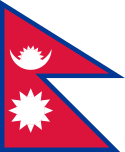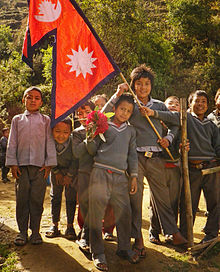 |
| Nepal in the globe |
 |
| flag of nepal Motto: जननी जन्मभूमिश्च स्वर्गादपि गरीयसी "Mother and Motherland are Greater than Heaven" |
By the mid-20th century, 20 out of Nepal’s only 22 high schools were built, financed, and managed by local communities. Successive governments continued this model, treating education as a partnership with communities. In 1972, however, the government took over the more than 8,000 existing schools. Because of the country’s remoteness and diversity—and weak government capacity—results were disastrous. Teachers regularly abandoned classrooms, the government was not able to provide adequate financing while community resources dried up, and quality plummeted. Finally, in 2001, Members of Parliament passed new laws to transfer schools back to community management. But 30 years of neglect had taken a heavy toll. Literacy rates were only 52%, compared 61% among low-income countries around the world.Currently the overall literacy rate (for population aged 5 years and above) has increased from 54.1% in 2001 to 65.9% in 2011. Male literacy rate is 75.1% compared to female literacy rate of 57.4%. The highest literacy rate is reported in Kathmandu district (86.3%) and lowest in Rautahat (41.7%).While the net primary enrollment rate was 74% in 2005;in 2009, that enrollment rate was at 90%.However increasing access to secondary education (grades 9-12) remains a major challenge, as evidenced by the disturbingly low net enrollment rate of 24% at this level. More than half of primary students do not enter secondary schools, and only one-half of them complete secondary schooling. In addition, fewer girls than boys join secondary schools and, among those who do join, fewer complete the 10th grade.
Literacy Rate (Average)65.9%
Literacy Rate (Male)75.1%
Literacy Rate (Female)57.4%
Despite such examples of success, there are problems and challenges. Education management, quality, relevance, and access are some of the critical issues of education in Nepal. Societal disparities based on gender, ethnicity, location, economic class, etc. are yet to be eliminated. Resource crunch has always been a problem in education. These problems have made the goal of education for all a challenge for the country.
 |
| total literacy rate of youth |
Education in Nepal is structured as school education and higher education. School education includes primary level of grades 1–5, lower secondary and secondary levels of grades 6–8 and 9–10 respectively. Pre-primary level of education is available in some areas. Six years old is the prescribed age for admission into grade one. A national level School Leaving Certificate (SLC) examination is conducted at the end of grade 10.
Grades 11 and 12 are considered as higher secondary level. Higher Secondary Education Board (HSEB) supervises higher secondary schools which are mostly under private management. Previously these grades were under the university system and were run as proficiency certificate level. Though some universities still offer these programs, the policy now is to integrate these grades into the school system.
Years in schools, colleges and universities
 |
| Students holding flag of Nepal |
- Lower Kindergarten (LKG)
- Upper Kindergarten (UKG)
- Nursery
- First Grade
- Second Grade
- Third Grade
- Fourth Grade
- Fifth Grade
- Sixth Grade
- Seventh Grade
- Eighth Grade
- Ninth Grade
- Tenth Grade - SLC (School Leaving Certificate) (A test based on Tenth Grade study. To appear in SLC exam the student must complete pre-test exam of Tenth Grade based on SLC exam pattern.)
- 10+2 (Intermediate Level) (Two years)
- Bachelors (three or four years)
- Masters (two years)
- M.Phil.
- Ph.D.
some facts

Nepal is one of the poorest countries in the world. 24% of population lives in less than 1$ a day.

1 in 5 children aged 6 to 10 are not in school.
The total cost to ensure a quality education and comprehensive support for each Nepali child that are sponsored is roughly 150$ a year. yet, this much is unattainable for many Nepali families
No comments:
Post a Comment